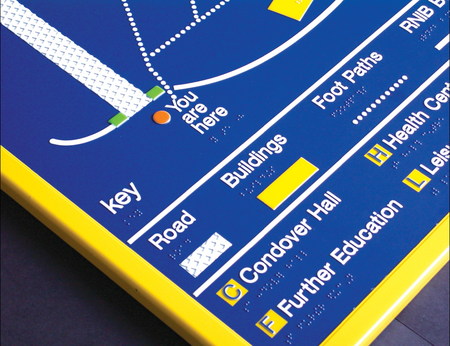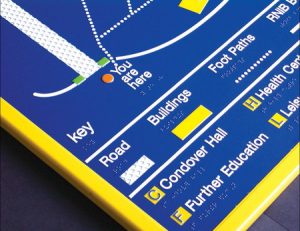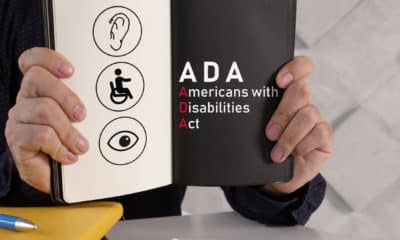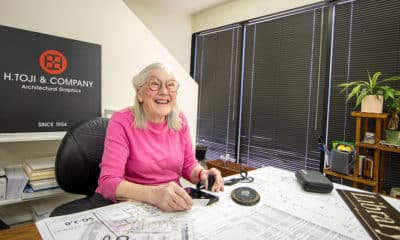The Americans with Disabilities Act (ADA) was adopted in 1990 to mandate civil-rights protections and promote mobility for the handicapped. Compliant signage and graphics that aid sight-impaired individuals comprise a portion of the legislation. Other countries soon followed suit with their own guidelines and regulations. (See related article on page 84.)
Eye Catch Signs (Halifax, Nova Scotia, Canada) has manufactured ADA-compliant architectural and audible signage since 1993. George Jeha, the company’s president, sought the input of governmental agencies and advocacy groups and helped developed regulations adopted by the Canadian Standards Assn.
Eye Catch manufactures Brailliant Touch® architectural signage, which incorporates scratch- and tamperresistant, first-surface graphics encapsulated within raised pictograms, letters and Braille symbols. To comply with ADA guidelines, the raised characters must rise at least 1⁄32 in. above the first layer and create a smooth, domed surface that’s comfortable for the user. To create the textured layers, Eye Catch uses a proprietary, vacuumforming system. The company sells on a wholesale basis to Canadian and American sign companies, and uses a distribution network abroad.
Fabricating signage for all sight-impaired individuals presents multiple considerations. In addition to serving the legally blind, environmental graphics must cater to those who suffer from low vision brought about through such conditions as macular degeneration, presbyopia and nearsightnedness. Meeting low-vision needs entails requiring high-contrast colors and icons – white or light-colored text and images against a darkred background is common.
“ADA signage has been increasingly assimilated to the larger graphic program,” Jeha said. “So, designers and architects increasingly recognize the need for icons and color palettes that meet the needs of the approximately 10 million sight-impaired people in the United States.”
Advertisement
The ADA Advisory Group (ADAAG) has added guidelines over the years, such as Braille grades II and Title 24 California Braille (these refined dot separations and textures). Further, different states and nations adopt different ADA-compliant letterstyles – most of the United States has adopted all-uppercase signage, whereas other places uses lowercase alphabets.
Because not all visually impaired people read Braille, and because some government authorities and businesses prefer compliments to tactile signage, audible signage maintains a niche in this market. Operating via an infrared sensor or pushbutton activation, audible signage plays CD or MP3 recordings that convey exit information and facility amenities (for instance, Eye Catch’s audio product offers 30-second to five-minute recordings). Audible-sign programs have been adopted gradually; Jeha sites San Francisco, which has been among the leading cities to comply with ADAAG regulations, as a locale where audible signage is most likely to be instituted.
Deborah Kendrick, executive director of the Cincinnati Assn. for the Blind and Visually Impaired, estimates that roughly 25 to 30% of buildings accommodate the needs of the visually impaired and surmised that these entities have a “long way to go.” However, she espouses helpful alternatives to conventional Braille signage.
“I like audible signage because not everyone can read Braille, and these enable almost universal accessibility,” Kendrick said. “Another helpful alternative is a videotape-sized device worn around the neck that contains a GPS system that uses a satellite system that’s accurate within 30 ft. of the user’s position. However, they’re very expensive and beyond the means of some people. Therefore, when ADA-compliant signage is absent, the visually impaired lack needed resources and may become disenfranchised.”
For more information on products for visually-impaired navigation, please visit www.senderogroup.com, www.humanware.com; or www.freedomscientific.com.



 Tip Sheet4 days ago
Tip Sheet4 days ago
 Business Management2 weeks ago
Business Management2 weeks ago
 Women in Signs2 weeks ago
Women in Signs2 weeks ago
 Real Deal5 days ago
Real Deal5 days ago
 Benchmarks1 day ago
Benchmarks1 day ago
 Editor's Note1 week ago
Editor's Note1 week ago
 Line Time2 weeks ago
Line Time2 weeks ago
 Product Buying + Technology1 week ago
Product Buying + Technology1 week ago








